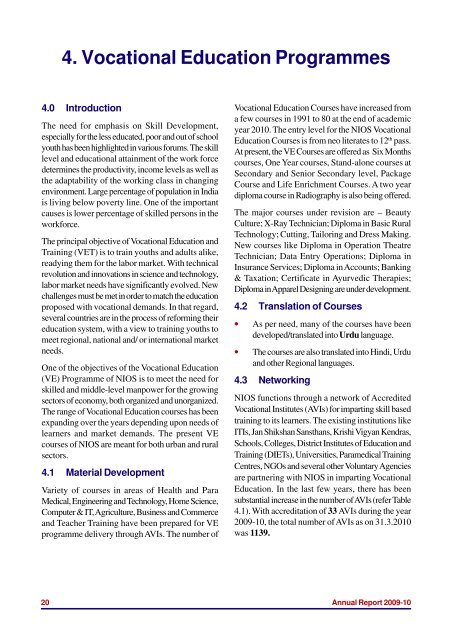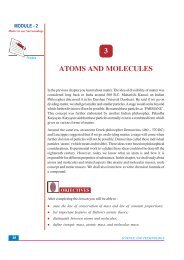2009-10 (16.6 MB) - The National Institute of Open Schooling
2009-10 (16.6 MB) - The National Institute of Open Schooling
2009-10 (16.6 MB) - The National Institute of Open Schooling
You also want an ePaper? Increase the reach of your titles
YUMPU automatically turns print PDFs into web optimized ePapers that Google loves.
<strong>National</strong> <strong>Institute</strong> <strong>of</strong> <strong>Open</strong> <strong>Schooling</strong><br />
4. Vocational Education Programmes<br />
4.0 Introduction<br />
<strong>The</strong> need for emphasis on Skill Development,<br />
especially for the less educated, poor and out <strong>of</strong> school<br />
youth has been highlighted in various forums. <strong>The</strong> skill<br />
level and educational attainment <strong>of</strong> the work force<br />
determines the productivity, income levels as well as<br />
the adaptability <strong>of</strong> the working class in changing<br />
environment. Large percentage <strong>of</strong> population in India<br />
is living below poverty line. One <strong>of</strong> the important<br />
causes is lower percentage <strong>of</strong> skilled persons in the<br />
workforce.<br />
<strong>The</strong> principal objective <strong>of</strong> Vocational Education and<br />
Training (VET) is to train youths and adults alike,<br />
readying them for the labor market. With technical<br />
revolution and innovations in science and technology,<br />
labor market needs have significantly evolved. New<br />
challenges must be met in order to match the education<br />
proposed with vocational demands. In that regard,<br />
several countries are in the process <strong>of</strong> reforming their<br />
education system, with a view to training youths to<br />
meet regional, national and/ or international market<br />
needs.<br />
One <strong>of</strong> the objectives <strong>of</strong> the Vocational Education<br />
(VE) Programme <strong>of</strong> NIOS is to meet the need for<br />
skilled and middle-level manpower for the growing<br />
sectors <strong>of</strong> economy, both organized and unorganized.<br />
<strong>The</strong> range <strong>of</strong> Vocational Education courses has been<br />
expanding over the years depending upon needs <strong>of</strong><br />
learners and market demands. <strong>The</strong> present VE<br />
courses <strong>of</strong> NIOS are meant for both urban and rural<br />
sectors.<br />
4.1 Material Development<br />
Variety <strong>of</strong> courses in areas <strong>of</strong> Health and Para<br />
Medical, Engineering and Technology, Home Science,<br />
Computer & IT, Agriculture, Business and Commerce<br />
and Teacher Training have been prepared for VE<br />
programme delivery through AVIs. <strong>The</strong> number <strong>of</strong><br />
Vocational Education Courses have increased from<br />
a few courses in 1991 to 80 at the end <strong>of</strong> academic<br />
year 20<strong>10</strong>. <strong>The</strong> entry level for the NIOS Vocational<br />
Education Courses is from neo literates to 12 th pass.<br />
At present, the VE Courses are <strong>of</strong>fered as Six Months<br />
courses, One Year courses, Stand-alone courses at<br />
Secondary and Senior Secondary level, Package<br />
Course and Life Enrichment Courses. A two year<br />
diploma course in Radiography is also being <strong>of</strong>fered.<br />
<strong>The</strong> major courses under revision are – Beauty<br />
Culture; X-Ray Technician; Diploma in Basic Rural<br />
Technology; Cutting, Tailoring and Dress Making.<br />
New courses like Diploma in Operation <strong>The</strong>atre<br />
Technician; Data Entry Operations; Diploma in<br />
Insurance Services; Diploma in Accounts; Banking<br />
& Taxation; Certificate in Ayurvedic <strong>The</strong>rapies;<br />
Diploma in Apparel Designing are under development.<br />
4.2 Translation <strong>of</strong> Courses<br />
• As per need, many <strong>of</strong> the courses have been<br />
developed/translated into Urdu language.<br />
• <strong>The</strong> courses are also translated into Hindi, Urdu<br />
and other Regional languages.<br />
4.3 Networking<br />
NIOS functions through a network <strong>of</strong> Accredited<br />
Vocational <strong>Institute</strong>s (AVIs) for imparting skill based<br />
training to its learners. <strong>The</strong> existing institutions like<br />
ITIs, Jan Shikshan Sansthans, Krishi Vigyan Kendras,<br />
Schools, Colleges, District <strong>Institute</strong>s <strong>of</strong> Education and<br />
Training (DIETs), Universities, Paramedical Training<br />
Centres, NGOs and several other Voluntary Agencies<br />
are partnering with NIOS in imparting Vocational<br />
Education. In the last few years, there has been<br />
substantial increase in the number <strong>of</strong> AVIs (refer Table<br />
4.1). With accreditation <strong>of</strong> 33 AVIs during the year<br />
<strong>2009</strong>-<strong>10</strong>, the total number <strong>of</strong> AVIs as on 31.3.20<strong>10</strong><br />
was 1139.<br />
20 Annual Report <strong>2009</strong>-<strong>10</strong>
















